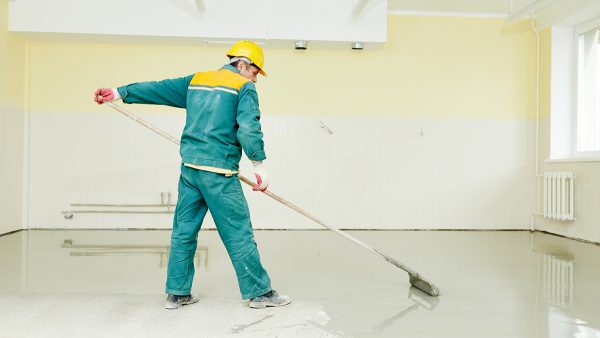How to paint commercial concrete floors

Commercial concrete floors take a beating.
Foot traffic, car traffic, stains, spills, you name it—a commercial concrete floor deals with it all. That means it needs a coating that can withstand the day-to-day rigors. If you decide to go with paint, you need to know that you have the process right. It needs to last, and if you do it right, it will. Here’s what you need to know.
Choose the right paint
When you see the price of commercial-grade concrete paint, you might be tempted to cheap out with DIY-level residential paint. Don’t.
Residential paint isn’t designed to stand up to the rigors of commercial traffic. Think of a family in a house—even a large family won’t come close to the traffic of a commercial structure. DIY paint will wear down, flake and chip away, leaving your concrete unprotected and open to wear.
Commercial-grade coatings are made to stand up to high traffic. They come in a couple of different options:
- Epoxy: resists moisture and stands up to traffic well. Commercial-grade epoxy coatings have a high solids percentage (usually 70%+). Good for indoor applications.
- Polyurethane: resists UV light well but lower adhesive. Lower solids percentage (60-70%). Good for outdoor applications.
Figure out which coating works best for your needs. Some floors may work best with a mix of the two and require add-ons like anti-slip.
Prepare the surface
Every painted surface needs preparation. You may not have to do much if it’s a new concrete surface. If it’s already been under some wear, you may have some work to do.
A commercial paint contractor will use various methods to prepare the concrete for coatings. These may include shot blasting, grinding, scarification, scabbling, and more. The process or methods used will depend on the amount of wear.
Cracks may also need to be repaired, but if they’re small enough, some coatings will cover them. Latex repair products make it harder for coatings to adhere; don’t use them.
The surface will need to be primed after it is prepared to make it ready to receive the new coating. Once this step is done, it’s ready to receive paint.
Paint the floor
Temperature and humidity have to be suitable for the coating to stick. Each coating may be slightly different; make sure you check what the specifications are.
Mixing, pouring, and rolling are the next step. There are a lot of variables in this process that are coating-specific. Don’t assume. You may need multiple coats to get your paint to the strength it requires.
You might be noticing a theme—commercial floor coatings are hard. Commercial paint requires an intimate understanding of the environment it’s being applied in, the products themselves, and the tasks those products have to perform. Bring an expert in. Contact JK Industries today and let us make your next commercial concrete floor perfect.
